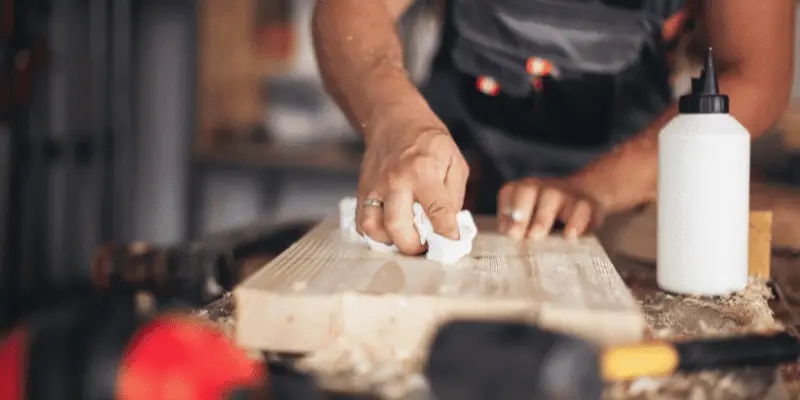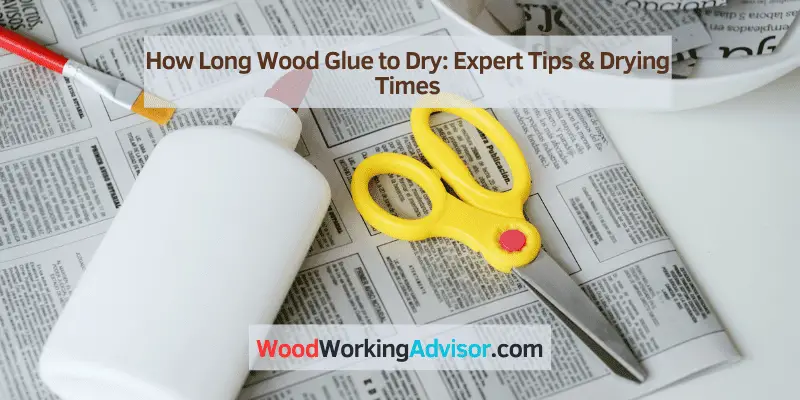Wood glue typically dries within 30 minutes to 24 hours, depending on the type and brand. The drying time also varies based on temperature and humidity levels.
When working on a woodworking project, ensuring that the wood glue has fully dried is crucial for the stability and durability of the final product. Failing to allow sufficient time for the glue to dry can result in weak bonds and compromised structural integrity.
Understanding the drying time of wood glue is essential for achieving successful and long-lasting results in woodworking projects. Additionally, considering the environmental factors that can affect drying time, such as temperature and humidity levels, is important for ensuring the optimal performance of the wood glue. To achieve the best outcomes in woodworking, allowing adequate time for the wood glue to dry is vital for the strength and reliability of the assembled pieces.
Understanding Wood Glue Drying Times
When working on woodworking projects, understanding wood glue drying times is essential for achieving strong and durable bonds. Knowing how long wood glue takes to dry is crucial for a successful project, as it ensures that the adhesive properly cures and forms a reliable connection between pieces of wood.
Importance Of Following Drying Times For Successful Wood Bonding
Following the recommended drying times for wood glue is crucial for achieving strong and durable bonds in woodworking projects. Proper adherence to drying times ensures that the adhesive has sufficient time to cure and create a reliable connection between the wood pieces being joined. Failing to follow drying times can result in weak bonds, compromising the structural integrity of the project and potentially leading to premature failure.
Factors Influencing Wood Glue Drying
Achieving optimal wood glue drying times is influenced by various factors that impact the curing process. These factors include ambient temperature and humidity, the specific type of wood glue being used, and the thickness of the glue line. Understanding and accounting for these variables plays a crucial role in ensuring that the wood glue dries and cures effectively, resulting in a strong and durable bond between the wood surfaces.
How Long Wood Glue To Dry: Variables
When it comes to woodworking projects, one of the crucial factors to consider is the drying time of wood glue. The duration wood glue takes to dry can vary due to several key variables. Understanding these variables is essential for achieving strong and durable bonds in woodworking projects. Let’s explore the various factors that influence how long wood glue takes to dry.
Type Of Wood Glue And Its Drying Characteristics
The type of wood glue used plays a significant role in determining the drying time. Different wood glues, such as polyvinyl acetate (PVA), polyurethane, and cyanoacrylate (CA) adhesives, have varying drying characteristics. PVA glues typically dry faster than polyurethane glues, while CA adhesives have an almost instantaneous drying time. Understanding the specific drying properties of the chosen wood glue is crucial for estimating drying times accurately.
Temperature And Humidity Effects
The environmental conditions, particularly temperature and humidity, play a crucial role in the drying process of wood glue. Higher temperatures generally accelerate the drying time, while excessive humidity can prolong the drying process. It’s essential to work in well-ventilated areas with optimal temperature and humidity levels to ensure efficient drying of wood glue.
Thickness Of Glue Applied And Wood Types Involved
The thickness of the glue application and the types of wood being bonded also impact the drying time. Thicker layers of glue may take longer to dry compared to thin, even applications. Additionally, porous woods may absorb the glue differently than denser woods, influencing the overall drying time. Understanding how the glue thickness and wood types interact is crucial for predicting drying times accurately.

Expert Tips For Efficient Glue Drying
Proper Application Techniques For Quicker Drying
Applying wood glue with precision and following the correct method can significantly speed up the drying process. Start by ensuring that the surfaces to be glued are clean, dry, and properly fitted together. Apply an even layer of wood glue, avoiding excess that can lead to longer drying times. Use clamps or other suitable tools to hold the pieces firmly in place to promote better adhesion and quicker drying.
Ideal Conditions To Speed Up The Drying Process
Creating the ideal environment for wood glue drying is essential to expedite the process. Temperature and humidity greatly influence drying time, so aim for temperatures between 70-75°F and humidity levels of 40-60%. Adequate ventilation and airflow help in expelling moisture, facilitating quicker drying. Additionally, ensuring that the glued surfaces are kept undisturbed during the drying process is crucial for optimal adhesion and efficiency.
Maximizing Wood Glue Effectiveness
Ensuring wood glue dries effectively is essential for strong and durable woodwork projects. By understanding how to achieve maximum adhesive strength and prevent common drying issues, you can optimize the performance of wood glue in your woodworking endeavors.
Achieving Maximum Adhesive Strength
When using wood glue, achieving optimal adhesive strength is crucial for the longevity and durability of your woodworking projects. To maximize the effectiveness of wood glue, consider the following tips:
- Ensure proper surface preparation by removing any debris, dust, and old adhesive residue from the wood surfaces.
- Apply even pressure during clamping to ensure a tight bond between the glued surfaces.
- Select the right type of wood glue based on the specific characteristics and requirements of your project, such as fast-drying, waterproof, or high-strength formulas.
Preventing Common Wood Glue Drying Issues
By understanding and addressing common wood glue drying issues, you can enhance the overall effectiveness of your glue application. To prevent these issues, consider the following strategies:
- Keep temperature and humidity levels within the recommended range for the specific type of wood glue you are using.
- Allow sufficient drying time as per the manufacturer’s instructions to ensure a complete and strong bond between the wood surfaces.
- Avoid overapplication of glue, as excessive amounts can lead to prolonged drying times and potential bond weaknesses.
Drying Times For Various Wood Glues
When it comes to woodworking, selecting the right wood glue is crucial for ensuring a strong and durable bond. However, the drying times for various types of wood glues can vary, impacting the efficiency of your project. Understanding the drying times for different wood glues is essential for planning and executing your woodworking projects effectively.
Pva (polyvinyl Acetate) Drying Time
PVA, or commonly known as white glue, is a popular choice among woodworkers due to its versatility and ease of use. The drying time for PVA wood glue is relatively quick, usually taking around 30 minutes to 1 hour to set, and reaching full strength within 24 hours. However, it’s important to note that factors such as temperature and humidity can affect the drying time of PVA glue, so it’s essential to consider these variables when working with PVA glue.
Epoxy Resin Drying Time
Epoxy resin wood glue is well-known for its strong and durable bond, making it ideal for heavy-duty woodworking projects. In terms of drying time, epoxy resin typically takes longer to cure compared to other wood glues. It can take anywhere from 8 to 24 hours to set, with full strength achieved within 48 to 72 hours. While the extended drying time may require patience, the resulting bond is resilient and long-lasting, making epoxy resin a preferred choice for high-stress applications.
Cyanoacrylate (super Glue) Drying Time
Cyanoacrylate, commonly referred to as super glue, is a fast-acting adhesive that is ideal for small woodworking projects and repairs. Unlike PVA and epoxy resin, cyanoacrylate glue sets almost instantly upon contact with the wood surface. Within seconds, the super glue forms a strong bond, with full strength reached within 24 hours. Due to its rapid curing properties, super glue is perfect for quick fixes and precision bonding tasks in woodworking.
Expert Insight: Wood Glue Drying Times
Wood glue drying times play a crucial role in woodworking projects, affecting the overall assembly and finishing process. While manufacturers provide estimated drying times, real-world experiences often differ. This expert insight delves into the actual drying times compared to manufacturer claims, along with case studies and expert experiences, shedding light on the practical aspects of wood glue drying.
Real-world Drying Times Versus Manufacturer Claims
Wood glue manufacturers typically provide estimated drying times on product labels or technical specifications. These times serve as a general guideline for users, but real-world scenarios often reveal variations. Factors such as temperature, humidity, and wood type can significantly impact the actual drying time of wood glue. Additionally, the application method and thickness of the glue layer can also influence the drying process.
That said, it’s important for woodworkers to consider these factors and conduct their own testing to determine the precise drying times for their specific projects. Real-world experience often highlights the need for adjustments to account for these variables, ensuring the successful completion of woodworking endeavors.
Case Studies And Expert Experiences On Drying Times
In a series of case studies, woodworkers and experts have shared their experiences with wood glue drying times, providing valuable insights for the woodworking community. These real-life scenarios demonstrate the necessity of considering environmental conditions, wood species, and project requirements when assessing drying times.
Moreover, expert guidance on optimizing drying times and achieving stronger bonds can improve the overall quality of woodworking projects. Learning from the real-world experiences and advice of seasoned professionals can help woodworkers better understand and anticipate the drying time variations associated with different wood glue formulations and working conditions.
Frequently Asked Questions Of How Long Wood Glue To Dry
Do You Have To Wait 24 Hours For Wood Glue To Dry?
Wood glue typically takes around 24 hours to fully dry. However, factors such as humidity and temperature can affect drying time. It’s recommended to wait the full 24 hours to ensure a strong bond.
How Long To Let Wood Glue Dry Before Removing Clamps?
Let wood glue dry for at least 30 minutes before removing clamps. Keep it clamped for up to 24 hours for a secure bond.
What Is The Fastest Way To Dry Wood Glue?
The fastest way to dry wood glue is to use a hairdryer on a low heat setting. Hold the hairdryer 6 inches away from the glue and move it back and forth until the glue is dry. Alternatively, you can use a fan to speed up the drying process.
What To Do If Wood Glue Dries Too Fast?
If wood glue dries too fast, try working in small sections or using a slower-setting glue. Increasing humidity can also extend drying time, or try adding a diluent to slow the process. Keep your work area cooler and avoid direct sunlight to prevent fast drying.
Conclusion
In short, the drying time for wood glue can vary depending on factors like temperature and humidity. Following the manufacturer’s guidelines is crucial for successful bonding. Understanding the drying process is essential for ensuring a strong and durable bond. With proper application and patience, you can achieve professional-quality results in your woodworking projects.



2 thoughts on “How Long Wood Glue to Dry: Expert Tips & Drying Times”